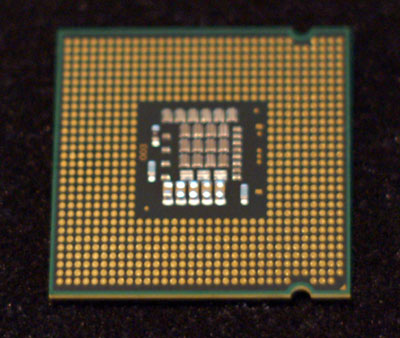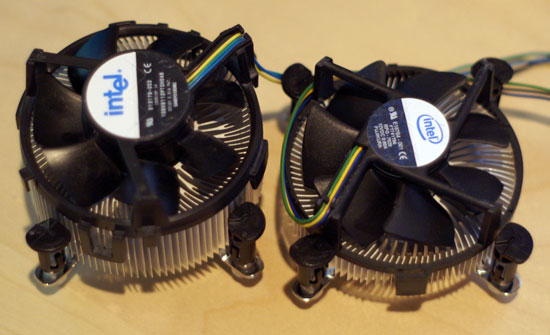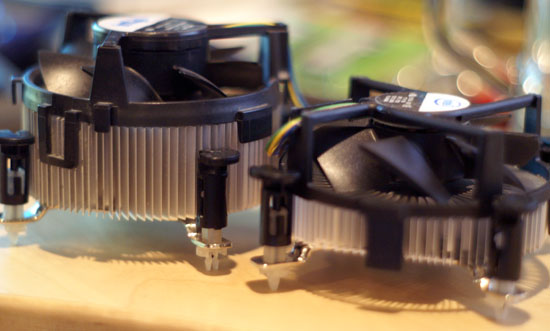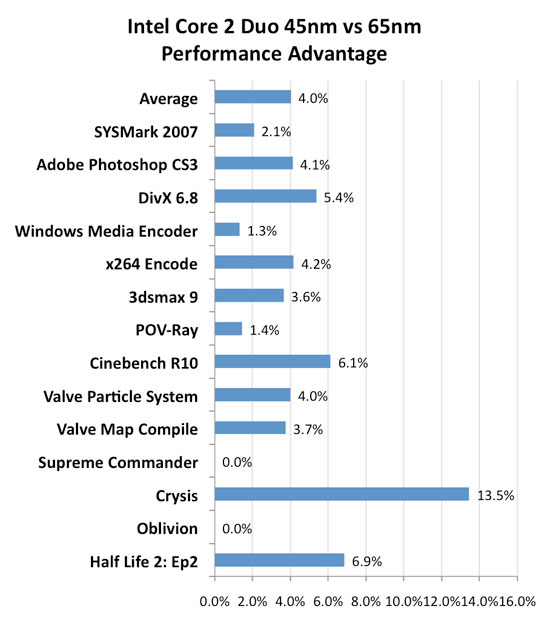Higher Clock Speeds, No TLB Issues and Better Pricing: The New Phenom
by Anand Lal Shimpi on March 27, 2008 12:00 AM EST- Posted in
- CPUs
Wolfy, How Fast Art Thou?
One of the first things we did when we got our hands on Intel's 45nm quad core parts was determine if they were any faster than the 65nm chips at the same frequency. It turns out that the performance difference wasn't huge, but the power savings at the (theoretically) same cost makes the move to 45nm a step forward.

We never did the same for the 45nm dual core (Wolfdale) parts, so here you go.
The new retail Wolfdale (45nm dual core) based CPUs come with a super low profile, very quiet heatsink:

The old heatsink (left), the new heatsink (right)

It's so cute
Intel is taking power and performance per watt more seriously now than ever before, you can expect its next designs (Nehalem and beyond) to be even more impressive in this regard.

The average performance increase for Intel's 45nm Wolfdale based Core 2 Duo is exactly 4%, which isn't quite as big as what we saw in the Q9300 vs. Q6600 comparison but still something. There are definite, tangible gains in some applications but we're mostly looking at single digital percentage improvements here.
Let's have a look at power:
| System Idle Power | System Load Power | |
| Intel Core 2 Duo E8200 (2.66GHz) | 114W | 138W |
| Intel Core 2 Duo E6750 (2.66GHz) | 116W | 158W |
Power improves, but not as much as the Q9300 did over the Q6600, partially because cache sizes have actually gone up in this case (4MB to 6MB) while they went down with the Q9300 (8MB to 6MB).
We're not expecting to see price parity between the 45nm and 65nm Core 2 Duos until Q3 of this year, waiting will obviously give you a faster, cooler running chip - but not necessarily by a huge amount.










65 Comments
View All Comments
aju - Thursday, March 27, 2008 - link
Ok, the fastest Phenom is still not quite as fast as the Q6600. The problem is that the cost issues is really much larger than it is made to seem in the article. The review does not really figure the total system price into the equation. The exact parts listed in the review for the test AMD system with an Phenom X4 9850 would cost $864.97. The exact parts listed for the Intel system with a Core2Quad Q6600 would cost $1273.96. Were talking about a difference of $405.99 here. For that price difference, you could forgo the 8800GT and put in 4 Radeon HD 3870s in its place and have quad CrossFire for a total of $1314.94. That MSI board supports 4 PCI Express 2.0 slots. Then we would be comparing systems at a similar price point. I wonder if the Intel system could keep up on the games then.coldpower27 - Thursday, March 27, 2008 - link
The situation would not change dramatically if Intel was changed back to DDR2-800. Intel processors don't benefit significantly if at all from the extra memroy bandwidth.This is a performance of the processor without limitation of other components, not a price/performance article.
IvanAndreevich - Thursday, March 27, 2008 - link
Can we have a bench with the Q6600 running the same FSB and clockspeed as the Q9300? Would be an interesting comparison.Schugy - Thursday, March 27, 2008 - link
Seems like q'n'q 2.0 still isn't working as good as the specs on paper tell us.Nihility - Thursday, March 27, 2008 - link
I'm really disappointed by Intel's 45 nm Q9300.Doesn't overclock as well, less cache and only marginally better performance over the Q6600.
Intel is obviously holding back because AMD can't deliver. I am not amused.
The updated phenoms are nice and all but as an overclocker I'll have to pass on this entire generation from BOTH manufacturers. That and WOW does AMD get owned at the gaming benchmarks.
coldpower27 - Thursday, March 27, 2008 - link
From an overclockers perspective yes, but what's not to like if your buying this product for stock performance, faster then the Q6600 with less cache, and much more efficient energy wise.The only chips that AMD and Intel sell that are geared toward overclocking in mind are AMD's Black Series, and Intel's Extreme Series..
They have no obligation to sell you cheap overclockable processors. If they do it's just very well a bonus.
Nihility - Friday, March 28, 2008 - link
From a stock perspective, it's more expensive than a Q9300 but offers marginal performance gains.I don't like marginal processor upgrades. It's a bad sign when a year later you get sold the same speed processors instead of something that is 50% faster. They could obviously be releasing these processors with much higher clock rates but they choose not to so they have that option to crank performance up another useless 5% if they feel like it.
I don't like being toyed with, can you blame me?
nubie - Thursday, March 27, 2008 - link
Hot Damn! Now I am torn between a 45nm Intel and a Tri/Quad AMD.I guess I can afford to sit back and wait, but this is just awesome news, it seems for professional apps the AMD is actually a better value (well duh), I think the Opteron line will be in high demand, and it will probably be very competitive.
Finally, something that is nearly clock-for-clock competitive with Intel. Now if AMD can only get Dual-core models out in 45nm, then they might be able to compete on level ground in the mainstream segment.
I just don't know which to buy, I hope that the promised AM2 compatibility will finally be here, if not there will be a lot of unhappy motherboard owners (my DFI Infinity M2 sorely needs one of these.)
strikeback03 - Thursday, March 27, 2008 - link
umm, they aren't really clock-for-clock competitive, and no one said they were. Depending on pricing they may be price competitive, but the Q9300 seems to hold a decent performance advantage over the 9850 in most tests shown.mczak - Thursday, March 27, 2008 - link
What was the stepping of the Q6600 core used here? IIRC G0 had significantly lower idle power consumption, and somewhat lower load power consumption than B3.